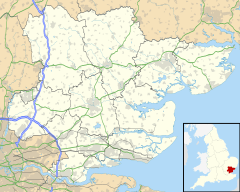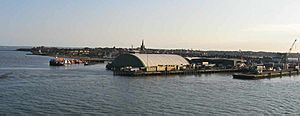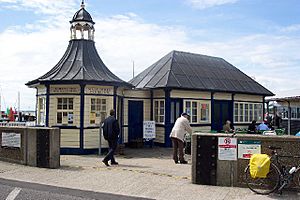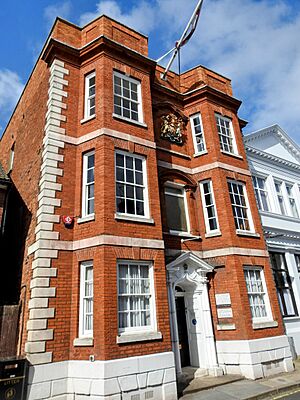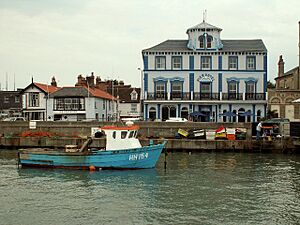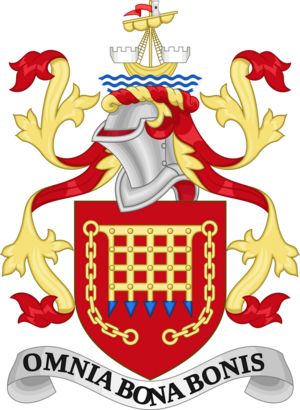Harwich facts for kids
Quick facts for kids Harwich |
|
|---|---|
 |
|
| Population | 17,684 (2011) |
| OS grid reference | TM243313 |
| District |
|
| Shire county | |
| Region | |
| Country | England |
| Sovereign state | United Kingdom |
| Post town | HARWICH |
| Postcode district | CO12 |
| Dialling code | 01255 |
| Police | Essex |
| Fire | Essex |
| Ambulance | East of England |
| EU Parliament | East of England |
| UK Parliament |
|
Harwich is a town located in Essex, England. It's one of the important Haven ports on the North Sea coast. Harwich is part of the Tendring district. Nearby towns include Felixstowe to the north-east, Ipswich to the north-west, Colchester to the south-west, and Clacton-on-Sea to the south. It is the most northern coastal town in Essex.
Harwich is special because of its location where the Stour and Orwell rivers meet the sea. This spot was very useful for sailors, as it was the only safe place to anchor ships between the Thames and the Humber rivers. This made Harwich important for both trade and military activities for a long time. It became a naval base in 1657 and was heavily protected with forts like Harwich Redoubt.
Harwich is likely where the famous ship Mayflower started its journey. This ship carried English Puritans to North America. It's also thought to be the birthplace of the Mayflower's captain, Christopher Jones.
Today, Harwich is connected to Dovercourt. These two towns, along with Parkeston, are often called "Harwich" together.
Contents
Harwich: A Town with a Rich Past
The name "Harwich" comes from an old English word meaning "military settlement." This shows how important the town was for defense long ago.
Harwich officially became a town in 1238. However, people lived there even earlier. Records show a chapel existed in 1177, and there are signs that the Romans might have been there too.
In 1339, during the Hundred Years' War, French forces tried to attack Harwich, but their raid failed.
Harwich and Famous Events
Because of its important location, Harwich was a target for William of Orange when he tried to invade Britain in 1688. This event is known as the Glorious Revolution. However, strong winds forced his ships to sail away, and he landed somewhere else.
The writer Daniel Defoe visited Harwich in 1722. He wrote about its strong fort and its huge harbour. He also mentioned a special spring on Beacon Hill that locals believed could turn wood into iron! Defoe thought this was due to minerals in the water. He described Harwich as a "town of hurry and business," not a place for fun, but where some people were very rich.
Harwich played a big role in the Napoleonic Wars and both World Wars. Here are some key moments:
- 1793–1815: During the Napoleonic Wars, Harwich was a Post Office Station for talking with Europe. It was also a base for sending troops to Holland and for capturing enemy ships. The local dockyard built many ships for the Navy. One ship, HMS Conqueror, captured the French Admiral Villeneuve at the Battle of Trafalgar. The Harwich Redoubt fort was built around this time.
- 1914–1918: In World War I, Harwich was a base for the Royal Navy's light cruisers and destroyers. British submarines were also based there. In November 1918, the German U-boat fleet surrendered to the Royal Navy right in Harwich harbour.
- 1939–1945: During World War II, Harwich was a main base for minesweeping ships and destroyers on the East Coast. It was also a base for British and French submarines. Fleets of ships gathered here for the evacuations from Holland and Dunkirk. Harwich was even attacked by Italian bombers during the Battle of Britain.
The Harwich Dockyard was set up as a Naval Dockyard in 1652. It stopped being a main Royal Dockyard in 1713, but the Royal Navy still had a presence there until 1829. During wars with France and Holland, the dockyard built and repaired many warships. For example, HMS Conqueror, a 74-gun ship finished in 1801, captured the French admiral Villeneuve at Trafalgar.
During World War II, parts of Harwich were again used by the Navy. Ships were based at HMS Badger. Even after Badger closed in 1946, the Royal Naval Auxiliary Service kept an office there until 1992.
Harwich Lighthouses

In 1665, two lighthouses were built on the Town Green. They acted as "leading lights" to guide ships safely into the harbour. These lighthouses were completely rebuilt in 1818. Both towers are still standing today, even though they stopped working as lighthouses in 1863. New lights were built at Dovercourt instead.
Getting Around Harwich
The Royal Navy no longer has ships based in Harwich. However, Harwich International Port at nearby Parkeston is still very busy. It offers regular ferry services to the Hook of Holland (Hoek van Holland) in the Netherlands.
Many operations for the Port of Felixstowe and for Trinity House, which manages lighthouses, are run from Harwich.
Harwich is famous for the old saying "Harwich for the Continent." You could see this on road signs and in old train advertisements.
From 1924 to 1987, a special train ferry service ran between Harwich and Zeebrugge in Belgium. This allowed whole trains to travel across the sea! The place where the trains boarded the ferry still exists today.
Harwich Architecture: A Walk Through Time
Harwich is known for its amazing old buildings. The entire older part of the town is a "conservation area," meaning its special look is protected.
The town's streets are laid out in a regular pattern with main roads and many small alleys. This shows that Harwich was planned way back in the medieval times. Many old buildings from that period are still there, often hidden behind newer fronts from the 1700s.
Most of the medieval buildings are private homes. The house in the picture of King's Head Street is special. It's a sailmaker's house, thought to be built around 1600. Important public buildings include the parish church of St. Nicholas, built in 1820-22 in a Gothic style. It has many original features, including an old organ. The Harwich Guildhall from 1769 is the only Grade I listed building in Harwich, meaning it's very important historically.
The Pier Hotel, built in 1860, and the Great Eastern Hotel, built in 1864, can both be seen on the quayside. These buildings show how important the town became for travelers after the Great Eastern Main Line railway arrived from Colchester in 1854. The Great Eastern Hotel later became the Harwich Town Hall.
Other interesting buildings include the High Lighthouse (1818), the unique Treadwheel Crane (from the late 1600s), and the Old Custom Houses on West Street. You can also see many Victorian shopfronts and the Electric Palace Cinema (1911). This cinema is one of the oldest purpose-built cinemas still standing with its original look and working projection room.
More recent buildings include the lifeboat station and two new buildings for Trinity House. The Trinity House office building was finished in 2005. These newer buildings have a modern, "high-tech" style.
Harwich International Shanty Festival
Since 2006, Harwich has hosted an annual International Shanty Festival every October. This festival celebrates the town's seafaring history and heritage through concerts, singing sessions, pub gatherings, talks, and workshops. Local people and international groups take part. This special event attracts visitors from all over the country and beyond. It is one of the biggest shanty festivals in the UK.
Notable People from Harwich
Harwich has been home to many famous people, especially those connected to its maritime past.
- Christopher Newport (1561–1617) – A sailor and privateer who captained the expedition that founded Jamestown, Virginia.
- Christopher Jones (c.1570–1622) – The captain of the Pilgrim ship Mayflower in 1620.
- Samuel Pepys (1633–1703) – A famous diarist and a Member of Parliament (MP) for Harwich.
- Sir Anthony Deane (1638–1721) – A Mayor of Harwich, a naval architect, and also an MP.
- Captain Charles Fryatt (1872–1916) – A mariner who was executed during World War I and later buried in Dovercourt.
- Peter Firmin (1928- 2018) – An artist and puppet maker, known for creating characters like Bagpuss.
- Liana Bridges (born 1969) – An actress, known for co-presenting Sooty & Co.
- Kate Hall (born 1983) – A British-Danish singer.
Politicians Connected to Harwich
Several politicians have also had ties to Harwich:
- Sir John Jacob, 1st Baronet (c.1597–1666) – A politician who served in the House of Commons.
- Sir Capel Luckyn, 2nd Baronet (1622–1680) – Another politician who served in the House of Commons.
- Tony Newton, Baron Newton of Braintree (1937–2012) – A Conservative politician and former Cabinet member.
- Bernard Jenkin (born 1959) – A Conservative politician, who has been the MP for Harwich and North Essex since 2010.
Sports in Harwich
Harwich is home to several sports clubs. These include Harwich & Parkeston F.C. (football), Harwich and Dovercourt RFC (rugby), and Harwich & Dovercourt Sailing Club. There's also the Harwich, Dovercourt & Parkeston Swimming Club, and Harwich Runners, who organize the annual Harwich Triathlons.
Harwich in the Media
Local news and TV shows for Harwich are provided by BBC East and ITV Anglia.
For radio, the town is served by BBC Essex and BBC Radio Suffolk. Other radio stations include Heart East, Greatest Hits Radio Essex, and Radio Mi Amigo, a local community station that broadcasts from The Harwich Quay.
The local newspaper for the town is the Harwich and Manningtree Standard, which comes out on Fridays.
Arms
See also
 In Spanish: Harwich para niños
In Spanish: Harwich para niños


